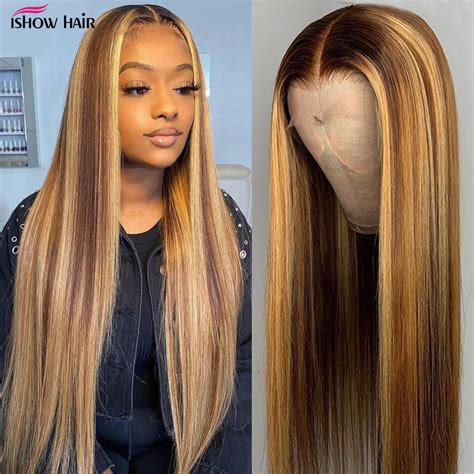Light Density Lace Front Wigs: The Ultimate Guide to Featherlight Luxuriousness

A light density lace front wig features a lace base with a lower hair density, typically ranging from 80% to 130%. This results in a sheerer, more natural-looking scalp that blends seamlessly with your skin tone.
- Breathable and Comfortable: They allow for better air circulation, reducing scalp irritation and heat buildup.
- Lightweight: They feel like a feather on your head, providing all-day comfort.
- Scalp-Like Appearance: The sheer lace base creates the illusion of a natural scalp, making it virtually undetectable.
- Versatile Styling: You can style them in various ways, from sleek to voluminous, without the bulk of heavy hair.
- Ideal for Fine or Thin Hair: They provide volume and coverage without weighing down natural hair.
Consider these factors when selecting a light density lace front wig:
- Hair Texture and Density: Choose a wig that matches the texture and density of your natural hair for a more seamless blend.
- Lace Color: Opt for a lace color that closely resembles your skin tone for an invisible effect.
- Cap Size: Measure your head circumference to ensure a snug and secure fit.
- Budget: Light density lace front wigs can range in price from $100 to over $1,000, depending on the quality and features.
- Prepare Your Hair: Braid or cornrow your natural hair to create a smooth base.
- Apply Lace Glue: Apply thin strips of lace glue along the perimeter of the wig cap.
- Apply the Wig: Position the wig on your head and press it firmly into place, starting from the front hairline.
- Smooth and Blend: Use a wig brush or flat iron to smooth the wig and blend the hairline with your natural hair.
- Secure with Hairspray: Spray a light layer of hairspray along the perimeter to hold the wig in place.
To maintain the longevity and pristine condition of your light density lace front wig, follow these tips:
- Wash Regularly: Wash your wig every 1-2 weeks with a gentle, sulfate-free shampoo.
- Condition: Apply a moisturizing conditioner to restore moisture after washing.
- Detangle: Use a wide-tooth comb to gently detangle your wig when it’s damp.
- Avoid Heat: Limit the use of heat styling tools, as excessive heat can damage the lace.
- Store Properly: When not in use, store your wig on a wig stand or in a breathable wig box.
Beyond the traditional uses of light density lace front wigs, explore these creative applications:
- Hair Toppers: Use them to add volume or cover thinning areas in your natural hair.
- Ponytail Extensions: Create a voluminous ponytail without the bulk of a full wig.
- Bangs: Enhance your hairstyle with fashionable, low-density bangs.
- Face-Framing Pieces: Add subtle highlights or color accents around your face.
Table 1: Lace Front Wig Density Comparison
| Density | Appearance | Benefits | Drawbacks |
|---|---|---|---|
| 50-80% (Light) | Sheer, natural | Breathable, lightweight | May appear see-through |
| 80-130% (Medium) | Semi-sheer, scalp-like | Versatile, good balance | May not be as breathable as light |
| 130-180% (Heavy) | Full, voluminous | Adds fullness, conceal hair loss | Heavy, less natural |
Table 2: Average Prices of Light Density Lace Front Wigs
| Quality | Cost |
|---|---|
| Synthetic | $100-$300 |
| Human Hair | $300-$1,000 |
| Remy Human Hair | $500-$1,500 |
Table 3: Lace Colors for Light Density Lace Front Wigs
| Lace Color | Skin Tones |
|---|---|
| Transparent | Fair to light |
| HD (High Definition) | Medium to dark |
| Swiss (Light Brown) | Medium |
| Medium Brown | Tan to olive |
| Dark Brown | Deep to chocolate |
Table 4: Maintenance Frequency for Light Density Lace Front Wigs
| Maintenance | Frequency |
|---|---|
| Washing | Every 1-2 weeks |
| Conditioning | After every wash |
| Detangling | When damp, as needed |
| Trimming | Every 6-8 weeks |
- Use a wig cap under your wig to reduce slippage and protect natural hair.
- Apply mousse or hairspray to the roots to create volume and prevent the wig from looking flat.
- Avoid wearing your wig for extended periods to prevent scalp irritation.
- Invest in a wig stand to keep your wig in place when not in use.
- Regular brushing and detangling will extend the lifespan of your wig.
1. How often should I wash a light density lace front wig?
Every 1-2 weeks.
2. What is the lifespan of a light density lace front wig?
With proper care, it can last up to 6-12 months.
3. How do I conceal the hairline of my wig?
Use a wig grip or blend it with your natural hair using hairspray or gel.
4. Can I use a light density lace front wig to cover bald spots?
Yes, it can provide natural-looking coverage for thinning areas.
5. How breathable are light density lace front wigs?
They are more breathable than heavier density wigs, allowing for better scalp ventilation.
6. Can I style a light density lace front wig with heat?
Limit the use of heat, as excessive heat can damage the lace.
7. How do I remove a light density lace front wig?
Use a lace glue remover to gently dissolve the adhesive and lift the wig.
8. How do I store a light density lace front wig?
Store it on a wig stand or in a breathable wig box to maintain its shape and prevent tangles.
